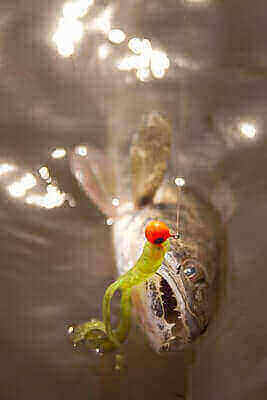Disclosure: We may earn commissions if you purchase products after clicking on a link from our site.
Do you want to learn how to catch more saugers? Saugers are very sensitive to light and you will find them in deeper water to escape the light from the sun. They are feisty and taste great. This makes them appealing to anglers. In this article, we share sauger fishing tips to help you catch and take more sauger home.
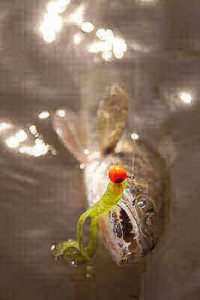
Table of Contents
How To Catch Sauger
1. Vertical Jigging
Vertical jigging is a highly effective fishing technique employed by anglers to target sauger, a prized freshwater game fish known for its delectable taste and challenging fights. This method involves dropping a weighted jig vertically beneath the boat and allowing it to sink to the desired depth where saugers are likely to be holding.
Anglers then impart subtle or erratic movements to the jig by raising and lowering the rod tip, mimicking the natural motions of prey species. Sauger, often found near the bottom of rivers or in deep pools with swift currents, are attracted to the enticing movement of the jig and are quick to strike.
Successful vertical jigging for saugers requires patience, keen observation of underwater structures, and adjustment of jigging techniques to match the fish’s feeding preferences. With its versatility and ability to effectively target saugers in various water conditions, vertical jigging remains a favored method among anglers seeking a thrilling and productive day on the water.
2. Trolling
Trolling is another fishing method used by anglers to catch saugers. Trolling is a popular and productive fishing method utilized by anglers to target sauger, a prized freshwater game fish known for its delectable taste and spirited fights. This technique involves trailing one or more baited lines behind a moving boat at varying speeds, allowing anglers to cover a wide area of water while presenting their lures or bait rigs to sauger dispersed throughout the water column.
Anglers often employ diving plugs, crankbaits, or live bait such as minnows to entice sauger into striking. By adjusting the speed and depth of the trolling presentation, anglers can effectively target saugers at different depths and in various areas of the waterway, including deeper pools, river channels, or along rocky shorelines. Trolling allows anglers to explore large bodies of water such as rivers or reservoirs, effectively locating schools of sauger and capitalizing on their feeding patterns.
With its versatility and ability to cover vast stretches of water, trolling remains a favored method for anglers pursuing sauger, promising an exhilarating and rewarding fishing experience on the water.
3. Drift Fishing
Drifting is a popular and effective fishing technique employed by anglers to target sauger, prized freshwater game fish known for their delectable taste and challenging fights. This method involves allowing a boat to drift naturally with the current while presenting bait or lures to sauger dispersed throughout the water column.
Anglers typically use live bait such as minnows or nightcrawlers rigged on a jighead or a bottom rig to entice sauger into striking. By drifting along river channels, rocky points, or other areas with promising sauger habitats, anglers can effectively cover a wide area and locate active fish. Successful drifting for the sauger requires careful attention to the speed and direction of the drift, as well as the strategic positioning of bait presentation to target the sauger holding in areas of current breaks or structure.
With its simplicity and effectiveness in presenting bait or lures to sauger in their natural environment, drifting remains a favored method among anglers seeking a thrilling and productive day on the water.
4. Still Fishing
Still fishing, though less commonly used for sauger compared to other methods like drifting or trolling, can still be effective under the right conditions. This method involves anchoring or holding a boat in a stationary position while presenting bait or lures to sauger.
Anglers typically use live bait such as minnows or nightcrawlers, rigged on a jighead or bottom rig, to entice sauger into striking. By targeting areas with promising sauger habitats, such as deep pools, rocky points, or underwater structures, anglers can effectively cover a specific area and wait for sauger to come to them.
Patience and careful observation of the water conditions and sauger behavior are key to successful still fishing. While it may require more patience compared to other methods, still fishing can yield rewarding results, especially when targeting sauger in specific areas where they are known to congregate.
How To Catch Sauger From The Bank
When fishing for sauger from the bank, look deep, dark, and swift water. Sauger likes to hang around that area. You will also find them around drop-offs where there is a significant change in the depth of the water. They will be in the re waiting for baitfish.
Additionally, areas of the water with strong currents will attract saugers. Lures, like jigs, and baits are often used when fishing for saugers. Jigging, trolling, and drifting are used when fishing for saugers.
Sauger Fishing Tips
1. Vertically jig using a large heavy jig up to 1 ounce. The jig can be soft plastics, feathers, or hair. The heavy jig will get down to the area where a sauger can be found.
2. Saugers are attracted to deeper, darker, and swifter water than walleyes.
3. Short jigs do a better job of reducing current, while longer jigs work well in stronger flows.
4. Saugers like slow-moving, and deep rivers. They can also be found in lakes and reservoirs. Being a migratory species, you will find saugers in a lot of habitats.
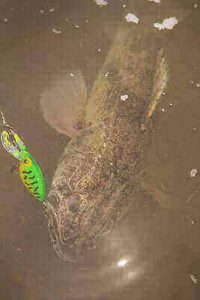
5. Adult saugers feed on leeches, crayfish, smaller fish, channel catfish, freshwater drum, and Grizzard shad. Smaller sauger eats insects and invertebrates.
6. Look for saugers in shallow water with cover, gravel bars, sandbars, and holes, and at points where two rivers meet in the fall.
7. In spring, saugers spawn. You will find them upstream in gravel or sandy bars downstream from dams and lock walls. They can also be found around rocks, debris, and along eddies.
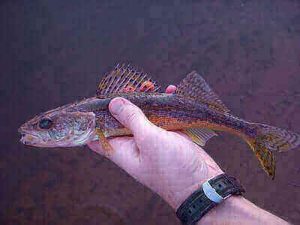
8. Look for saugers in deer waters during the summer. In early summer, look for saugers near deep gravel bars and holes away from the shore. Late in summer, saugers can be found downstream from tailwaters near drop-offs and holes near confluences.
9. Early fishing when the sun is rising or late in the evening can be the best time to fish for saugers. Saugers come near the shore to feed during early mornings or late evenings.
10. Sauger tends to linger close to the bottom in some areas. You will need to bring your lure down to them. Just touch the bottom and hold for a few seconds. Then use a slow retrieve to tempt the sauger to follow and get bites. You may not get any bites if you move it too fast.

11. The color of the lure you use depends on the water you are fishing in. Use bright-colored lures or spinners in clear water and darker colors in murky waters.
12. Since saugers are not as aggressive or active as other species like bass, go with a tackle of medium weight. Additionally, choose a 7 to 9-foot rod and reel setup with average action for best line control. Get a fishing line that is close to a 10 lb test depending on how deep you will fish.
13. Saugers are very sensitive to scents, especially pheromones that lure females during the mating season. Therefore, if you are using scents, don’t overuse them. It will put off the sauger.
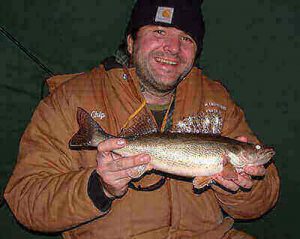
14. The best way to get the attention of saugers is using spinnerbaits or other kinds of flashy lures as they like to follow an object. Use a spinning lure that has 3 “spinners” if you want to catch saugers with a simple spinning lure.
15. If you haven’t been successful in catching saugers with bait or lures, try different approaches like float fishing, spin casting, or spinner baiting. You have to factor in how active and aggressive a sauger is to know which method to use.
16. Pulling a three-way rig up current is another presentation to fish for saugers.
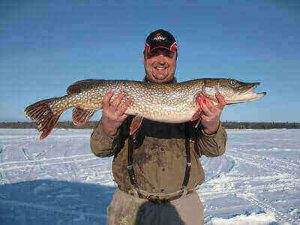
Sauger Fishing Gear
1. Rods & Reels
A medium-heavy spinning rod that is 6 or 7 feet and a reel will do the job for fishing saugers. Fishing rods and reels are essential gear for anglers targeting sauger, prized freshwater game fish known for their delicious taste and challenging fights. When fishing for saugers, anglers typically use medium to medium-heavy spinning or baitcasting rods paired with quality reels equipped with smooth drag systems.
These rods provide the necessary sensitivity to detect subtle strikes from sauger, while also offering the power and backbone to handle their strong runs and spirited fights. Anglers often spool their reels with monofilament, fluorocarbon, or braided fishing lines, depending on personal preference and fishing conditions.
Additionally, the versatility of fishing rods and reels allows anglers to employ various techniques such as casting, trolling, drifting, or still fishing when targeting saugers in different environments and water conditions. With their reliability and effectiveness in handling the unique challenges of sauger fishing, fishing rods, and reels remain indispensable tools for anglers seeking a thrilling and productive day on the water.
2. Fishing Line
A monofilament line with an 8 to 12-pound test line will work for fishing saugers. Fishing line is a crucial component of the fishing gear arsenal when targeting sauger, esteemed freshwater game fish known for their delectable taste and spirited fights. Anglers typically opt for monofilament, fluorocarbon, or braided lines when pursuing sauger, selecting line weights and strengths appropriate for the fishing conditions and techniques employed.
Monofilament lines offer stretch and forgiveness, which can be advantageous when fighting sauger, while fluorocarbon lines provide low visibility and abrasion resistance, ideal for fishing in clear water or around rocky structures. Braided lines offer superior sensitivity and strength, allowing anglers to detect subtle strikes and handle the powerful runs of sauger.
Additionally, anglers often use leaders or line weights to adjust the presentation depth when fishing for sauger in different water depths and currents. With their versatility and reliability, fishing lines play a crucial role in ensuring anglers have the necessary control and responsiveness to effectively target sauger, ensuring an enjoyable and rewarding fishing experience on the water.
3. Hooks
A size #1, 1/0, 2/0, or 3/0 will do the job for sauger fishing. Hooks are fundamental fishing gear for anglers targeting sauger, esteemed freshwater game fish known for their delicious taste and spirited fights. When fishing for sauger, anglers typically use small to medium-sized hooks, ranging from #2 to #6 in size, depending on the bait or lure being used and the size of the sauger being targeted.
Hooks may be rigged with live bait such as minnows or nightcrawlers, or used to secure artificial lures like jigs or crankbaits. Sharp and sturdy hooks are essential for effectively hooking and landing sauger, as these fish can exhibit subtle strikes and strong runs.
Anglers may also opt for specialized hooks such as treble hooks or circle hooks when targeting saugers in specific environments or using particular techniques. With their reliability and importance in securing a successful catch, hooks remain a fundamental component of the fishing gear arsenal for anglers pursuing sauger, ensuring an enjoyable and rewarding fishing experience on the water.

Best Sauger Lures
1. Jigs
Jigs are indispensable lures for anglers targeting sauger, revered freshwater game fish known for their delectable taste and spirited fights. These versatile lures consist of a weighted head adorned with a soft plastic body or feather tail, designed to mimic the appearance and movement of natural prey. Anglers can choose from a wide range of jig sizes, colors, and styles to match the preferences of sauger in different water conditions.
Jigs are typically fished by casting and retrieving or vertically jigging near submerged structures, rocky points, or river channels where saugers are known to congregate. The lifelike action and realistic presentation of jigs make them highly effective in enticing sauger to strike, especially when paired with live bait such as minnows or nightcrawlers. With their versatility and proven effectiveness, jigs are a go-to lure choice for anglers pursuing sauger, promising an exhilarating and rewarding fishing experience on the water.
2. Spoons
Spoons are versatile and effective lures for anglers targeting sauger, esteemed freshwater game fish known for their delectable taste and challenging fights. These lures typically feature a curved, metallic design resembling a small baitfish or minnow, with a reflective finish that produces enticing flashes underwater.
Anglers can manipulate spoons with various retrieval techniques, such as a steady retrieve or occasional twitching motion, to imitate the natural movements of injured prey. When fished near submerged structures, rocky points, or river channels where saugers are known to congregate, spoons can produce enticing vibrations and flashes that attract saugers to strike.
With their versatility in presentation and ability to cover a large area of water, spoons offer anglers a reliable and exciting option for pursuing sauger, ensuring an enjoyable and productive fishing experience on the water.
3. Crankbaits
Crankbaits are highly effective lures for anglers targeting sauger, prized freshwater game fish known for their delectable taste and spirited fights. These lures typically feature a hard-bodied design with a diving lip that allows them to dive to specific depths in the water column, making them ideal for targeting sauger holding near submerged structures, rocky points, or river channels.
Anglers can select crankbaits of varying sizes, colors, and diving depths to match the preferences of sauger in different water conditions. By retrieving the crankbait at a steady pace, anglers can simulate the movements of injured baitfish, enticing sauger to strike.
With their lifelike action and ability to cover a large area of water, crankbaits offer anglers a reliable and exciting option for pursuing sauger, ensuring an enjoyable and productive fishing experience on the water.
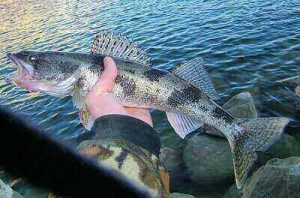
Sauger Live Bait
1. Nightcrawlers
Nightcrawlers serve as a tried-and-true bait option for anglers targeting sauger, esteemed freshwater game fish known for their delicious taste and spirited fights. These large earthworms emit a natural scent and exhibit subtle movement when rigged on a hook, enticing sauger to strike.
Anglers typically present nightcrawlers near submerged structures, rocky points, or river channels where saugers are known to congregate. Whether fished on a jighead or bottom rig, nightcrawlers offer versatility and effectiveness in enticing sauger into biting.
With their availability at bait shops and proven track record in attracting saugers, nightcrawlers provide anglers with a reliable and rewarding option for pursuing these prized freshwater game fish, ensuring an enjoyable fishing experience on the water.
2. Minnows
Minnows are an exceptional bait choice for anglers targeting sauger, revered freshwater game fish known for their delectable taste and challenging fights. These small fish emit a natural scent and exhibit lively swimming motions, making them irresistible to sauger.
Anglers typically rig minnows on hooks or jigheads and present them near submerged structures, rocky points, or river channels where saugers are known to congregate. Whether fished beneath a float or slowly retrieved along the bottom, minnows offer versatility and effectiveness in enticing sauger into striking.
With their availability at bait shops and proven success in attracting saugers, minnows provide anglers with a reliable and rewarding option for pursuing these prized freshwater game fish, ensuring an enjoyable and productive fishing experience on the water.
3. Shad
Shad serves as a versatile and effective bait option for anglers targeting sauger, esteemed freshwater game fish known for their delectable taste and spirited fights. These silvery baitfish emit a natural scent and possess a realistic appearance that entices sauger to strike.
Anglers often rig shad on hooks or jigheads and present them near submerged structures, rocky points, or river channels where saugers are known to congregate. Whether fished alive or as cut bait, shad offers versatility and effectiveness in enticing sauger into biting.
With their availability and proven success in attracting saugers, shad provides anglers with a reliable and rewarding option for pursuing these prized freshwater game fish, ensuring an enjoyable and productive fishing experience on the water.
The Bottom Line
Saugers are unique fish as they are very light-sensitive and will move away from the light. They are tasty and this makes them a good target for anglers. If you want to learn how to catch more saugers, then we shared sauger fishing tips to help you be more successful in fishing for saugers whether you are a beginner or an experienced angler.
If you also fish for bluegill, then this article on bluegill fishing tips will help you catch more bluegill. You can also read trout fishing tips for beginners, bluefish fishing tips, pike fishing tips, and redfish fishing tips.
